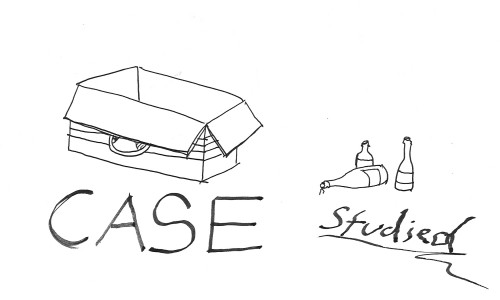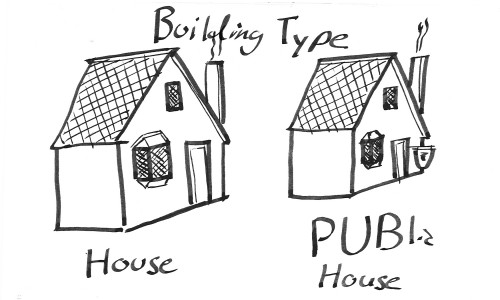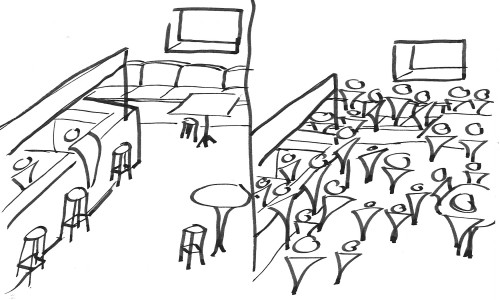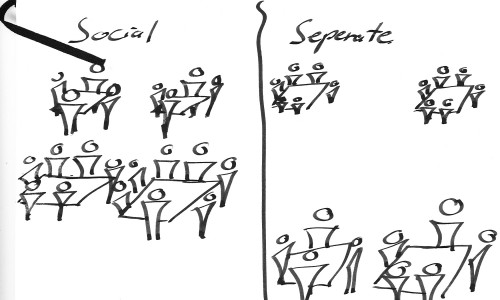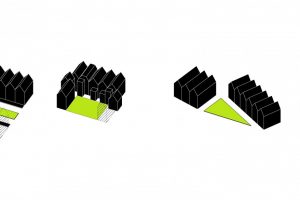Because, why not. is a new series of articles written by Michael Nugent about going out into the world and asking the “stupid questions” about design, architecture, the urban landscape and the nature of society simply by analyzing and doing things for lack of a reason not to.
Case for a Case: Why we should be doing case studies on pubs
To understand the architectural significance of the pub, one must first experience it which requires one to enter a local pub, sit down and order a pint. Followed by another. And another. And another until the room begins to spin and the world fades to black. Maybe thats not entirely necessary, but is highly recommended because it provides its own type of entertainment.
Now we can move on to a completely serious article in which I attempt to regain what little credibility I began with by delving into the architectural significance of the pub, tavern and bar. And then explain why it is an invaluable type of building experience especially compared to famous buildings from the great architects of the 20th century in distance cities which certain studios, that shall remain nameless, would have us study.

The key to studying a pub is what designers like Bruce Mau, David Kelley and Yves Behar call experiential research, which simply means getting out into the world and observing how everyday people go about interacting with their environment. Now, yes in this case that does on occasion involve sitting down with friends and having a pint, but more importantly is about stepping away from the drafting board and seeing how groups of lively (and drunk) people interact and inhabit space. In an era where holistic user experience is instigating a design revival, delving into small community social hubs such as pubs, cafés, and restaurants is crucial for understanding how to design good places.
Pubs in particular have a longstanding heritage as focal points for communities throughout commonwealth countries. Originating in Britain as a Public House, these spaces provided a welcoming place for the public to gather and socialize in. We can begin to base a serious architectural study upon the question of how pubs are designed to foster a social experience despite begin different by design. This can be understood through a serious of distinct scales at which pub operates, these are similar to architectural scales, in which a person can be related to the pub.
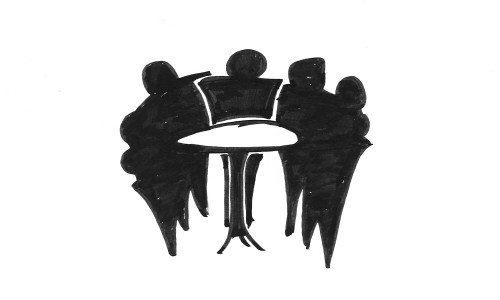
This set of scales starts with the single unit. A person. Their relationship to another person is the basis of their relationship to the pub, and can be understood as a human scale (one : one). The collective relationship between the individuals within in the pub is what creates the social atmosphere of a pub. Frankly there may be no worse feeling than being the only on in a pub (scale one : zero). In a group it becomes a social activity, surrounded by other groups all gathered for the same reason, to enjoy the company of others (and drink), thus giving everyone in the room something in common.
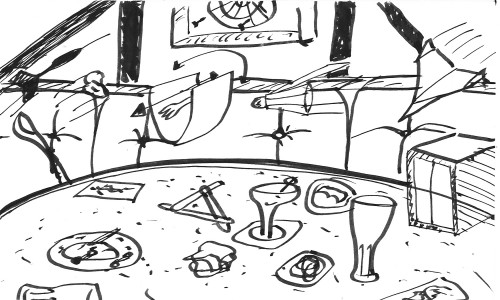
The group therefore is the next scale in the set (one : group), defined by the table, and this is were design comes into play. Everything about the table, anything on it and most importantly the people directly around it become the basis upon which an experience is built. Saltshakers, forks, napkins and empty draft glasses all become fare game for explaining how Bilbo saved the Dwarves, or how wormholes bend the fabric of space-time, or whatever the topic of discussion is for that particular evening. Those moments bring people together and build connections to a place, which is why they keep coming back. That’s how strangers become regulars, and regulars become friends, which in turns helps to form the identity of the place.
Adjacent bar-goers also affects the vibe of place, as the adjacent tables provide the backdrop for one’s experience. Which leads to the next scale in the set, separation (one : others). People like being surrounded by people, especially if they are there for the same reason, they just may not want to talk to them. Different table types provide variable levels of separation ranging from the private booth, to the public bar and a wide variety in between. A booth operates as a clearly defined, fixed and often slightly elevated space with partitions separating it from other booths to provide a level of intimacy for the company. Whether for two or ten, a booth is designed to allow a group to talk with each other while discouraging communication with others. The square table is a semi-private option by being both mobile and modular, allowing for tables to be clustered and chairs pulled up to accommodate groups of various sizes. The transient nature of the tables promotes more movement and interaction with other people in the pub as people can freely stand up and walk around. The bar counter is the architectural reverse to the booth, with freely arranged stools along a fixed, continuous element without any separations between people. This encourages the free range of standing, sitting, moving, and chatting.
The size and composition of these seating types becomes the next scale in the set as it presents a common experience for everyone in that area (one : crowd). This is where measurements become crucial to functionality of the space and numbers really start to matter. The distance of a foot can have a dramatic difference on how a space is perceived. The proximity of tables within a seating section will affect the level of privacy implied by the space. More tables positioned closer together reduces seclusion and encourages social behavior, while fewer tables farther apart implies social separation and privacy. People feel weird walking over to someone on the other side of the room and starting a conversation but cramming people together and lubricating them with alcohol stimulates conversations. Each seating section will behave in a different way, and that carefully orchestrated variety will encourage people to move around until they find the experience they are looking for.
Every restaurant, bar, tavern or pub is made of the same parts, plus/minus a patio, pool table and a TV. But, it is how those elements are uniquely organized and proportioned in relation to each other that create the experience of a specific pub. This is when a pub begins to act as a cohesive entity not a collection of seat sections. Some could argue there is a word for that: architecture.
Like any piece of great architecture, every pub is unique which means the only way to write about them is as a building typology. Almost all pubs come with a story and character behind them, that is why they make such compelling subjects for architectural case studies, because every design decision has a discernible outcome. The ideas I have explored in this were generalized observation, from a variety of different places, but each location offered enough material to become an in-depth case study in it’s own right. The best part about doing these types of case studies (and its only partially because of the beer) is that they are everywhere. There is no need to travel far for this type of experiential research, all one need to do is go out into the world and start looking at spatial experiences as products of design. The lessons are out there, one simply needs to find them.


